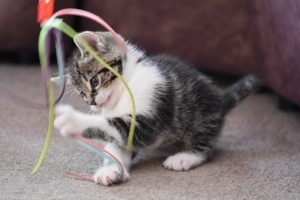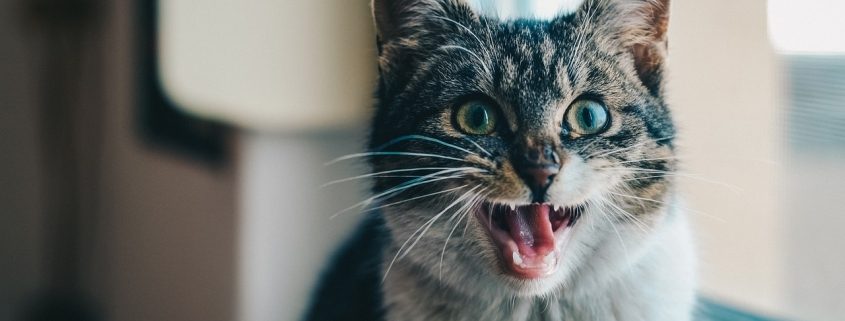Ask Crystal: Chewy Kitten
Welcome to “Ask Crystal,” where you can ask your pet behavior questions! You can submit your question for Crystal at the bottom of the page!

Hi Crystal,
About a year ago I adopted a kitten from BRHS. While she is sweet and adorable, she has increasingly been chewing on anything hard and that has a corner! Computer screen, laptop, thumb drives, glass or wood or marble tabletops… Luckily wires are not of interest. I’ve read someplace that cats don’t like citrus, so I rubbed a lemon on the corners of my laptop screen and monitor. Seemed to help for a little while, but now she licks those places. Was thinking she might be bored so I try to play with her to distract her and tire her out. Works sometimes, but not always. The vet recommended getting a Kong toy, but she has no interest in it, even if I put some food inside. I have a 13 yo cat, who is generally very sedate. They get along fine. I have a house guest who also has a cat, but he is being kept in a separate room and they have no contact. Wonder if you’ve run across this before – and if you have any suggestions.
Sincerely,
Stumped Cat Mom
Dear Stumped,
Most people don’t really think about cats needing to chew on things but just like dogs, cats also have a need to chew. Sometimes this behavior can start as a teething kitten because the kitten’s swollen gums are in pain. Kittens teethe between 3.5 and 7 months and often bite objects to relief the pain. The behavior continues because the cat got some enjoyment out of that feeling. Cats also explore with their mouths so there can be an element of that in the beginnings of this behavior.
The first step in addressing a behavioral concern is to rule out medical causes. A cat with gum disease may chew on objects to sooth the pain. Redness in the gums can be a sign of dental problems. A cat may chew on objects if it has gastrointestinal issues as well. You would likely notice drooling and/or licking in those cases. Pica is a condition when an animal eats nonedible items. This can be caused by nutritional deficiencies, or other medical and behavioral causes. An exam by a veterinarian is needed to determine causes.
Once you have taken her to the vet to rule out medical causes for the behavior, you can look at the behavioral causes of the behavior. Potential behavioral causes of chewing in cats are: obsessive compulsive disorder, anxiety, stress and boredom.
While some chewing in cats in normal and to be expected, most owners really start to take notice when it becomes more compulsive. A lot of the extreme chewing behaviors are brought on by anxiety. We tend to see it in more in high strung cats or cats that seem nervous or fearful.
You mentioned your guest has a cat, that could be an additional source of stress which could make the behavior worse potentially. Even if she doesn’t see the cat, she can still smell it and she knows it is there. It sounds like this behavior has been going on for a while so I don’t think that is the cause, but it could make it ramp up in frequency if it is a behavior rooted in stress and anxiety.
Over the counter products for anxiety include pheromones such as Feliway. You can purchase a plug-in diffuser, a spray that you can spray on bedding or the calming collar. There are also calming chews which contain thiamine, colostrum and L-Theanine which are shown to have calming effects. Rescue Remedy is an all-natural flower essence that may help to calm your cat.
If after reading and trying some tips, you feel that the behavior is compulsive in nature, I would suggest consulting your vet about medicines that might help with the anxiety if that is the cause of the behavior.
In regard to deterrents, that can depend on the cat and where the item is located. There are a number of things that cats do not like the smell of due to their superior sense of smell. Some of them are toxic to kitties so since we know she might lick, I would stick to those that aren’t toxic. Rosemary, thyme and cinnamon are a couple of spices that cats tend to not like. Some other things to try are tin-foil or double-sided tape.
 Redirecting unwanted behaviors is always a good thing to try. When she engages in the behavior, try to redirect onto a preferred cat chew toy. You may see if she likes silver vine which are sticks that are safe for cats to chew on and similar to cat nip. You may also consider plastic drinking straws for her to play with and bite on. Turkey or chicken jerky that is plain with no spices may satisfy an urge to chew as well. Otherwise, she may like to chew on soft cat chew toys. I know you mentioned trying redirection already and that is was hit or miss. I always like to remind people that behavior doesn’t travel in a straight line. It doesn’t just continue to improve until it goes away. She will have good and bad days but keep trying to redirect her from the behavior.
Redirecting unwanted behaviors is always a good thing to try. When she engages in the behavior, try to redirect onto a preferred cat chew toy. You may see if she likes silver vine which are sticks that are safe for cats to chew on and similar to cat nip. You may also consider plastic drinking straws for her to play with and bite on. Turkey or chicken jerky that is plain with no spices may satisfy an urge to chew as well. Otherwise, she may like to chew on soft cat chew toys. I know you mentioned trying redirection already and that is was hit or miss. I always like to remind people that behavior doesn’t travel in a straight line. It doesn’t just continue to improve until it goes away. She will have good and bad days but keep trying to redirect her from the behavior.
Boredom is the likely cause for most cats that are having an issue with chewing. We should provide a consistent schedule for the cat which consists of feeding enrichment, structured play time, petting, grooming and potentially adding in training.
The suggestion of enrichment feeding is a good idea. She may not like kongs but there are so many other enrichment feeding toys to try. A lot of times what happens is the feeder is too hard for the cat to start with or they aren’t really motivated to interact with it since they get free food all day. You can start with toys where you can use can food, chicken, tuna, egg or some other high value food. That usually helps gain their interest. You can transition to less valuable rewards as the cat gains interest.
When considering a cat enrichment feeder, think about how your cat likes to play and that may inform your decision of what to try. Most of the toys seem to revolve around the cat reaching in and digging food out. Some like the kong toy involve knocking the toy around which can be good for cats that love knocking toys around.
I am a huge fan of making my own enrichment items of household items. I love to use plastic Easter eggs to put can food in the bottom half and just leave the top half off. The cat licks it around and follows it as it moves. My cats love to rip paper so I like putting treats in paper bags for them to rip up. You could also put treats in boxes or cardboard tubes where you close one end and leave the other open.
Play should be centered around activities that you do with the cat such as using a wand toy rather than just expecting the cat to play with balls or other self- play toys. If your cat isn’t interested in wands, check out Jackson Galaxy’s website www.jacksongalaxy.com, he has videos to show how to play with your cat. He recommends playing with the cat before feeding so that it mimics how a cat would hunt. Have at least two play sessions a day.
Most people don’t realize that you can clicker train a cat. Training is a great way to engage an animal’s mind and develop a way to communicate with them. You would be amazed at how much you can teach a cat. My favorite YouTube page for cat training is Cat School. It was created by an Applied Animal Behaviorist so she really understands how to break behaviors down so they are easy to teach.
“Leave It” means to move away from something and come over to me. Leave it would be a great way to redirect her when you can see that she is about to start chewing. Put a cat treat in your hand and show it to your cat before closing your fist over it. Have a better treat in your other hand or in a bowl, chicken or tuna works well. Ignore any attempts to paw at your hand. If she is sniffing the hand, click and treat the second her nose comes off of your hand or if she looks away. Treat her from your other hand. Continue showing her the treat and closing your hand until she looks away immediately. Then say “leave it” right before showing her the treat in your hand. Again, click and treat for her looking away or moving away. Next, do the exact same steps but with a treat on the ground. If she looks away, click and treat. If she goes for the food, cover it up with your hand and say “leave it”. She must look away before you click and she can take that treat. Put a treat in your hand and show it to your cat before closing your hand over it. The object of the game is for her to look away or move away when being told “leave it“ and then she gets a yummy treat.
 The hard part about these types of behaviors is understanding what the cat is getting out of the behavior. It seems irrational to us to being chewing on these items but knowing that this is a natural need of cats may help to understand why she might be doing it. Like humans, cats can have irrational habits and we change their behavior in similar ways. Make sure she is healthy, that all of her needs are met and teach her some new habits and hopefully you will start to see an improvement in her behavior.
The hard part about these types of behaviors is understanding what the cat is getting out of the behavior. It seems irrational to us to being chewing on these items but knowing that this is a natural need of cats may help to understand why she might be doing it. Like humans, cats can have irrational habits and we change their behavior in similar ways. Make sure she is healthy, that all of her needs are met and teach her some new habits and hopefully you will start to see an improvement in her behavior.
If you do not see a change in behavior and it becomes concerning, consider contacting a cat behaviorist. The International Association of Animal Behaviorist has a locater of certified behaviorists: International Association of Animal Behavior Consultants (iaabc.org). These are behaviorists which have studied working with cats.
Until next time,
Crystal







